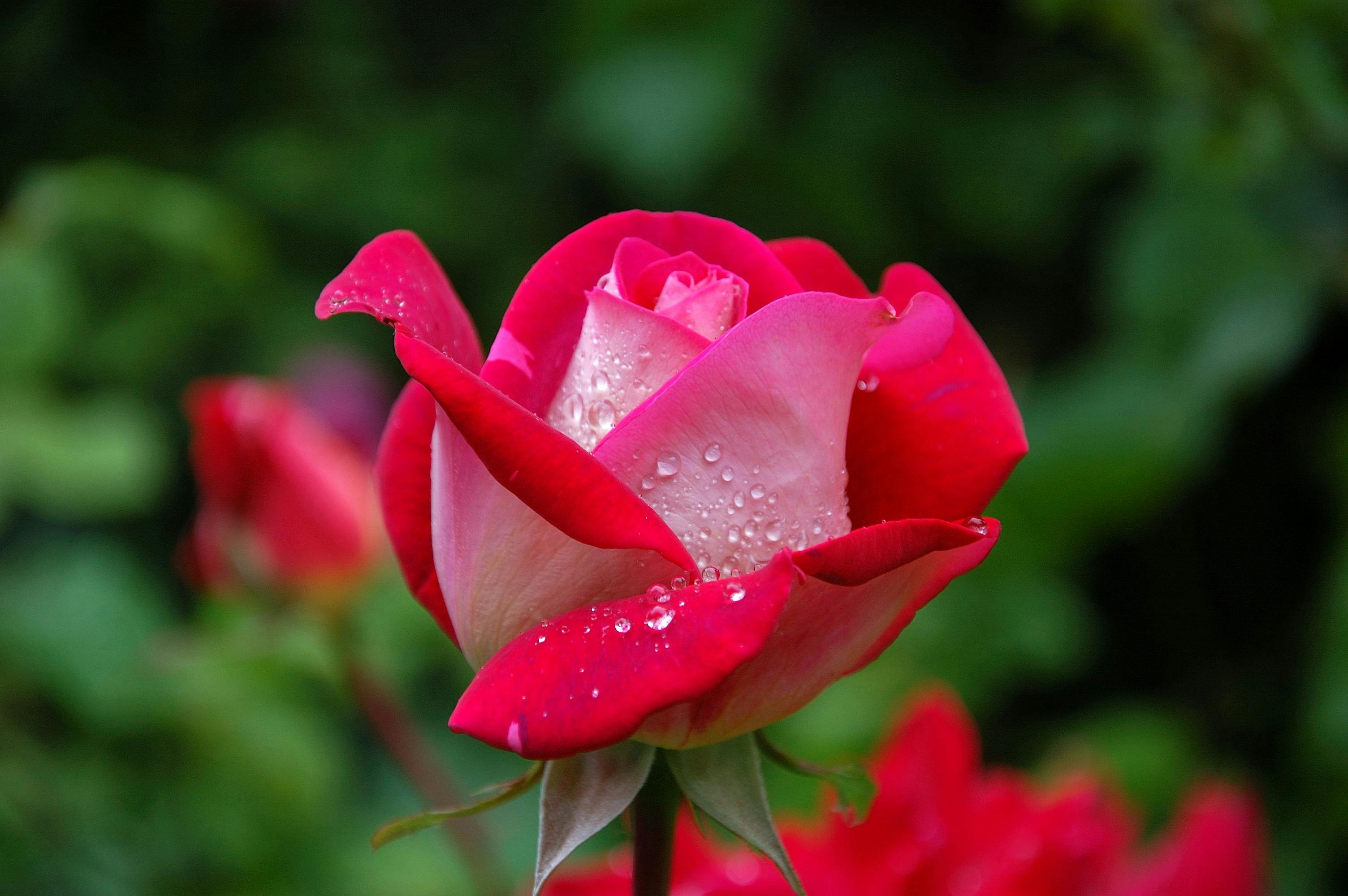The Miniature Rose Plant is a type of rose that has been specially bred to stay small and compact, making it perfect for use in miniature gardens and even in containers. These plants are renowned for their showy flowers, which come in a wide range of colors, shapes, and sizes. They are also known for their hardiness and ability to thrive in a variety of climates and soil conditions. They are a great choice for any gardener who wants to bring some color to their garden or patio without taking up too much space.A miniature rose plant is a type of rose that has been cultivated to stay small in size. Its flowers are typically the same size as any other rose, but the bush itself remains miniature. These roses are often used in gardens, containers and other small spaces. They can also be used in floral arrangements and provide an array of colors and fragrances.
Contents
Characteristics of Miniature Rose Plant
Miniature rose plants are a popular choice among gardeners due to their small size and bright colors. These plants are typically smaller than standard rose bushes, reaching heights of only 1-2 feet. They come in a variety of colors such as pink, red, yellow, white, and peach. Miniature rose plants can also be found in a range of bloom sizes from single petals to full double blooms. The foliage is usually glossy and dark green.
Miniature roses can tolerate fuller sun exposure than many other types of roses. They require well-drained soil and should be fertilized regularly for optimal growth. Pruning can help maintain the desired shape and encourage larger blooms. A mini rose bush should be watered deeply once or twice a week during the growing season in order to promote healthy growth.
Miniature rose plants require minimal maintenance yet they produce beautiful flowers throughout the summer months. These perennial plants are drought tolerant and disease resistant, making them ideal for gardeners who prefer low maintenance gardening. With proper care, miniature rose plants can continue to thrive for many years to come!
Advantages of Having Miniature Rose Plant
Miniature rose plants are becoming increasingly popular among home gardeners and plant enthusiasts alike. Not only are they beautiful to look at, but they also have many advantages over full-sized roses. Here are some of the main benefits of having a miniature rose plant in your garden:
The first advantage is that miniature rose plants require less care than larger varieties. They are hardy and easy to maintain, so you don’t need to worry about spending too much time tending to them. Additionally, miniature roses don’t need as much sunlight or water as other types of roses, making them a great option for those who don’t have a lot of time or resources to dedicate to gardening.
Another great benefit is that these plants produce more flowers than larger roses do. This means you can enjoy a greater abundance of blooms throughout the season. You’ll also find that miniature roses come in a variety of colors and sizes, so you can easily find one that will fit into any space in your garden.
Finally, miniature rose plants are relatively inexpensive compared to full-sized roses. This makes them perfect for those who want to add some beauty and color to their yard on a budget. They also make great gifts for friends and family who love gardening.
In summary, miniature rose plants offer many benefits over larger varieties, including being easy to maintain, producing more flowers than traditional roses, coming in various colors and sizes, and being relatively inexpensive.
Ideal Placement of Miniature Rose Plant
Miniature rose plants are becoming increasingly popular as an ornamental addition to both homes and gardens. Despite their small size, these roses are incredibly hardy and can thrive in many different types of environments. While miniature roses can be grown both indoors and outdoors, it is important to ensure that the environment created for the plant is suitable for its needs. In order to maximize the health and growth potential of your miniature rose, understanding the ideal placement for this type of plant is key.
The first key factor in determining the ideal placement for a miniature rose is light exposure. Miniature roses require a minimum of six hours of direct sunlight per day in order to thrive and produce healthy blooms. A south or west-facing window should provide adequate levels of light, although providing additional artificial light during winter months may help the plant stay healthy. Shade cloth may also be used to reduce the intensity of direct sunlight on hot days.
The second key factor in determining a suitable placement for a miniature rose is temperature control. These plants prefer temperatures between 60-85°F (15-30°C). The temperature should remain relatively consistent throughout the day and night, as sudden changes can cause stress to the plant which may hinder its growth or cause damage to its leaves or blooms. It’s important to ensure that your miniature rose isn’t exposed to temperatures below 40°F (4°C) or above 95°F (35°C).
Finally, when it comes to soil conditions, it’s important to make sure that your miniature rose has access to well-draining soil with plenty of organic material. Adding mulch around the base of your plant will help retain moisture while allowing excess water to drain away quickly, avoiding root rot or other issues related to overwatering. Regular fertilizing with a balanced fertilizer will also help keep your miniature rose healthy and allow it to thrive in its new environment.
By following these tips on ideal placement for a miniature rose you can ensure that your new addition will be happy and healthy for years to come!
Soil Requirements for Growing Miniature Rose Plant
Miniature rose plants require well-draining soil that is slightly acidic. The ideal pH range for miniature roses is between 5.5 and 6.5. They also need a soil that is rich in organic matter, so adding compost or aged manure can be beneficial. If the soil is sandy or clay-like, adding peat moss or other amendments can help improve drainage and aeration. When planting, make sure the rose bush has enough room to spread its roots and grow properly. Adding a layer of mulch around the base of the rose bush can help retain moisture and keep weeds away.
In general, miniature rose plants require regular watering throughout their growing season (spring to fall). Water deeply to ensure that all of the roots receive adequate moisture, but avoid overwatering as this can lead to root rot and other problems. Feeding your miniature roses with a balanced fertilizer every few weeks during their growing season will help keep them healthy and promote strong growth. Pruning should also be done regularly to keep the plant looking its best and prevent it from becoming leggy or unruly.

Water Requirements for Miniature Rose Plant
Miniature rose plants are easy to care and maintain, but they do require sufficient water. The amount of water needed depends on many factors, including where the plant is located, the temperature, and the type of soil. Generally, miniature rose plants should be watered every two to three days during the growing season and about once a week during the winter months. However, if there is a drought or extreme heat wave, more frequent watering may be necessary. It is also important to check the soil moisture before watering; if it is still moist from the previous watering, additional water is not needed.
When watering miniature rose plants, it is best to use a hose with a gentle spray head or a watering can with a fine nozzle. Too much pressure can damage delicate roots and foliage. The water should be applied slowly and evenly so that it reaches all parts of the root system. Additionally, avoid wetting foliage when possible since this can lead to fungal diseases. After watering, make sure that any excess water drains away from the plant so that its roots are not sitting in standing water.
Overall, miniature rose plants need adequate but not excessive amounts of water in order to thrive. Paying attention to soil moisture levels and providing consistent but gentle irrigation will help keep your miniature rose plants healthy and beautiful for years to come!
Fertilizer Requirements for Miniature Rose Plant
Miniature rose plants require fertilizing regularly during the growing season to keep them looking their best. While these plants are tolerant of a range of soils, they will benefit from regular applications of fertilizer. Fertilizers can be used to supplement the nutrients in the soil, or to make up for a deficiency in the soil. The best fertilizer for miniature roses is one that contains a balanced mixture of nitrogen, phosphorus and potassium. Nitrogen promotes leaf growth, phosphorus encourages root development and flowering, and potassium helps with overall plant health.
It is important to use a fertilizer specifically designed for roses when fertilizing miniature rose plants. This type of fertilizer has been formulated to provide the correct balance of nutrients that roses need. It is also important to use only the recommended amount of fertilizer indicated on the package instructions. Too much fertilizer can damage the plant’s roots and leaves, while too little will not provide the necessary nutrients for healthy growth.
For best results, apply fertilizer every four to six weeks during active growth periods in spring and summer. When applying fertilizer, it is important to water it in well to ensure that it reaches the soil around the roots. During winter months when growth slows down, reduce applications or skip altogether depending on your climate and location.
Overall, by following these simple tips you can ensure that your miniature rose plants will thrive and look their best throughout the year!
Pruning Miniature Rose Plants
Pruning miniature rose plants is one of the most important steps in maintaining a healthy and attractive garden. Pruning helps to promote new growth, reduce disease, and encourages abundant flowering. When pruning miniature roses, it is important to use sharp, clean pruning shears and to make sure all cuts are made at a 45 degree angle. Make sure to remove any dead, diseased, or damaged stems as well as any stems that cross over each other or are growing in an unnatural direction. Prune the plants back to just above the first set of five leaves and make sure not to remove too much foliage as this can stunt their growth.
Deadheading Miniature Roses
Deadheading is another important part of rose care as it encourages more flowers and helps prevent disease. To deadhead, simply remove spent blooms by pinching them off with your fingers or using shears. Make sure to cut the flower stem down to just above the first set of five leaves. Deadheading should be done regularly throughout the blooming season as this will help keep your rose garden looking neat and tidy while also encouraging repeat blooming.

Conclusion
Miniature rose plants are a great addition to any garden or landscape. They are easy to care for and require minimal attention, yet they provide a beautiful display of delicate blooms in an array of colors. These hardy plants are perfect for those with limited space or those who simply prefer smaller roses. While they may require some maintenance, including pruning and fertilizing, they can provide years of beauty and enjoyment with minimal effort. Miniature roses come in many varieties, so there is sure to be one suitable for any environment or preference.
No matter the size of your garden, miniature roses can add beauty, color, and fragrance while providing the same delight as their larger counterparts. Whether you prefer a single bloom or an entire bush full of them – miniature roses are sure to please.

0 Comments